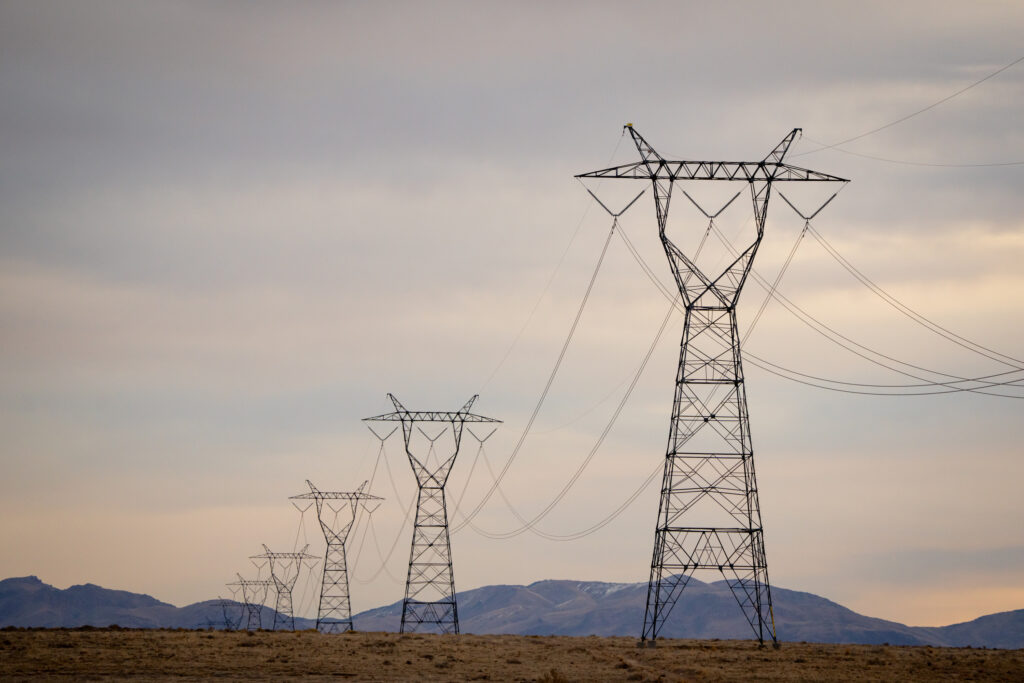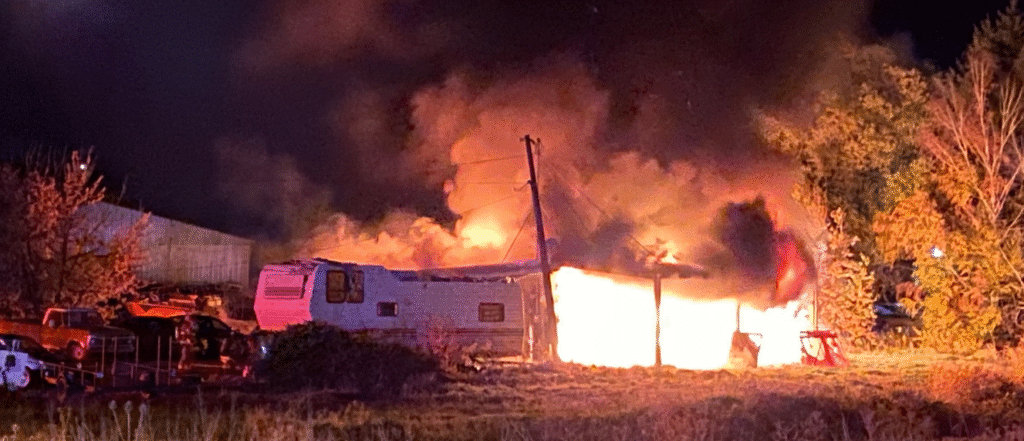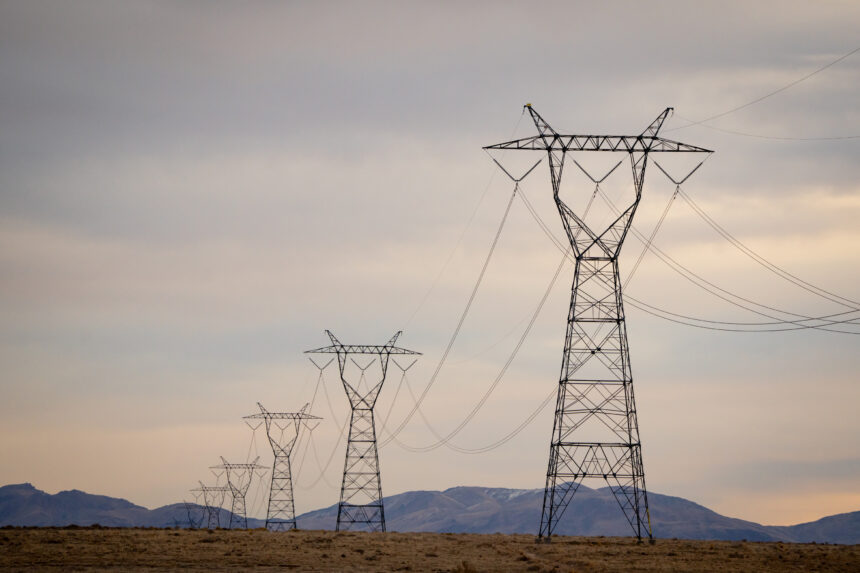
The following story was reported by The Utah Investigative Journalism Project in partnership with Utah News Dispatch.
When police in Moscow, Idaho, rolled up to the scene of the structure fire on Oct. 23, 2021, the home was a fireball.
The officers quickly took control of the scene and checked on the victims. One man, Elijah Froh, was sent to the hospital with serious burns on his torso. His employer, Kip Mock, also received a less severe burn on his arm.
Mock said he took “sole responsibility” and explained that he put “old diesel” into a wood-burning stove.
“When the old diesel went onto the fire, not exactly sure how it happened but the wood stove… it blew back,” Mock said.
They said the fire was all over Froh, even his beard was aflame, and they quickly ripped his shirt off and got him and everyone else out of the building.
“We’re grateful everybody’s alive,” Mock said.
The officer left to confer with another patrol officer, telling him he spoke with Mock, the leaseholder of the property.
“He’s the one putting diesel on the fire?” the officer asked, before replying. “Stupid f—ing idiot.”
The officers noted that “his buddy could have got killed” before discussing next steps for keeping the scene secure. As the officers talked, boisterous laughs came from Mock and the other young men who had fled the fire and were huddled together 50 feet away.
“They’re in pretty high spirits for just getting lit up,” one of the officers said.
Froh would sue his then-employer Mock alleging in a lawsuit that Mock “recklessly threw an accelerant on a fire,” and his “grossly negligent” actions caused an explosion, resulting in “physical disfigurement” and major medical expenses. The case was later dismissed and Froh now works with Mock at his new venture.
Mock’s most recent gig? Since 2024 he’s listed himself as head of operations for Valar Atomics, the company that has signed a deal with Utah to explore developing an advanced nuclear test reactor by 2026. Mock is leading the company’s efforts to build a reactor for the company in the Philippines to avoid the regulatory delays of being licensed by the U.S. Nuclear Regulatory Commission.
The company founders are all young, conservative scions of the startup culture of fast-paced innovation. But while that pace can be game changing, critics say it can also be reckless, and that nuclear power is not a space for entrepreneurs to “move fast and break things” as the popular Mark Zuckerberg motto goes.
Valar Atomics has been criticized by nuclear experts for making exaggerated safety claims for its products, even claiming a person could safely hold spent nuclear fuel from their reactors in their hands while receiving only a mild dose of radiation.
This at the same time they announced they were joining a lawsuit with other companies and the states of Texas, Arizona, Florida and Utah in suing the Nuclear Regulatory Commission, claiming the agency is holding back innovation. It’s a maneuver that critics say misinterprets the law to claim a safety exemption the company has simply not proven that they deserve. Valar Atomics also made news for securing $21 million in venture capital funding to build its first advanced test reactor.
Valar Atomics did not respond to multiple requests for comment for this story. Kip Mock also did not respond to questions for this story.
Dr. Anna Erickson is a nuclear engineer and professor at the Georgia Institute of Technology. She’s skeptical of the company’s claims. For all the hype about its small modular reactors, she notes it hasn’t made one and neither has anyone else in the country. But more importantly, Valar hasn’t even submitted a design for review with the Nuclear Regulatory Commission — while other startups have. Such a submission would show the public and regulators what its designs are about and how serious the technology is.
“I don’t know how you can claim your design is so safe without doing engineering. It’s not fairy dust — this is engineering. We can’t take your word for it,” Erickson said.

The nuke bros
Valar Atomics’ mission statement calls for the mass production of nuclear power generators.
“One standardized design built thousands of times, with a business model engineered for scale,” the statement reads. “Our approach will deliver abundant clean energy to power humanity’s future.”
According to their social media feeds and blogs, the leadership of the company themselves seem to be fueled by Red Bull, Monster Energy and tropical fruit flavored chewing tobacco.
On social media, Valar Atomics head of operations Mock mixes posts about worldwide energy production with jokes about becoming the governor of Greenland and pictures of his Porsche with the Valar Atomics logo painted on the side. He sings Elon Musk’s praises and muses about parenting – “1. If you abide by car seat recommendations, your kids will be coddled and impotent. 2. If you can’t afford a bigger car, you’re lame” — to also sharing “absolute banger” quotes from libertarian author Ayn Rand.
The company has also enlisted a slew of nuclear engineers, but the main buzz behind the company has been on founder Isaiah Taylor, the 25-year-old high school dropout and self-made entrepreneur who says he’s the great grandson of a physicist who worked on the Manhattan Project developing the first nuclear bomb.
One writer for Advisorpedia, a media site focused on financial advisers, described visiting Taylor in his cigar lounge at the company’s southern California headquarters.
“Leather armchairs anchor the room. Four enormous classical paintings span the wall. Columbus sighting land, Pilgrims stepping off the Mayflower, the signing of the Declaration, and the Constitutional Convention. This is a startup built on American ambition.”
But before he was taking interviews in a company cigar lounge, Taylor scraped his way up from much more modest beginnings.
On social media a commenter had derided Taylor as a “trust fund baby.” In response Taylor posted a long description of his life “mucking goat barns in the backwoods of Kentucky.”
“That job taught me to work harder than I thought was possible. To keep shoveling long past when my muscles didn’t want to. It also taught me how to operate a skid steer, chase cows on a four-wheeler, and repair hydraulics,” Taylor wrote.
“But at night, my hair still smelling like methane, I sat on the family computer (an old Dell with Windows XP) and wrote code.”
When he was 12 he said his father made him a deal. “I will go out and buy you a MacBook Pro today, if you shake hands that I don’t have to pay for your college.”
The two shook on it and Taylor got his computer, writing that while he imagined his father thought the computer would help him get a gig to pay for college, Taylor instead bypassed college.
“What he didn’t expect is that by the time I was 16 I would be making six figures, leading me to drop out of high school and skip college altogether.”
Taylor parlayed that into the Idaho-based auto repair company founded with Mock that then led them to Valar Atomics.
‘…a good engineer does not make claims about things he simply has no knowledge of’
Valar Atomics’ story has impressed many, including Utah Gov. Spencer Cox. In May, Cox announced the state had come to an agreement with the company to explore allowing Valar to use the Utah San Rafael Energy Lab in Emery County to build a small modular test reactor by 2026.

Some, however, have called out the company for misleading statements online.
When Valar Atomics joined the lawsuit against the NRC, it argued its technology was so safe that a person could hold the spent nuclear fuel from its reactor in their hand and get the same amount of radiation as one would expect from a hospital CT scan.
This caught the attention of a lot of people online, including Nick Touran, a nuclear engineer who since 2009 has worked with TerraPower, a company that is also working on small modular reactor design, and also started the WhatIsNuclear.com site.
When Touran pointed out that claim could not possibly be true, Taylor responded by providing some calculations and chastising Touran, saying “Nick, a good engineer does not make claims about things he simply has no knowledge of.”
When Touran then looked at the new data, he saw that holding Valar’s spent fuel would result in a fatal dose in 90 seconds. Another nuclear engineer used a more advanced calculation method to argue the fatal dose would actually be as fast as 85 milliseconds.
Taylor posted a reply stating: “I will follow up with a detailed writeup tonight or tomorrow, back to back today. Should be fun…”
Taylor also told Wired.com he was working on a response, but more than two months later no reply has been provided.
Touran said Taylor often lashes out at his “haters.”
“I don’t consider myself a hater, like I think what they’re doing is very interesting and cool and I’m glad they have people out there building nuclear hardware and building up the skills needed to build nuclear equipment,” Touran said. “I think that’s all awesome.”
But Touran believes posting an absurd safety claim and then personally attacking people double-checking the math on it demonstrates a lack of maturity.
“Given his hypersensitive and toxic reaction to my simple critique of his outrageous radiation claim, I think his reactor should be scrutinized quite a bit by independent experts before anyone allows him to turn it on,” Touran said.
Valar’s website and its lawsuit against the NRC argues that the intent of the 1954 Atomic Energy Act was to exempt certain small reactors from regulation because they did not present the same health and safety risks as larger, more traditional nuclear reactors.
But the company is not proposing building just one small reactor, it is proposing building hundreds of the small reactors in a single area.
Touran said this “nuclear farm” idea really overstates its cost and safety benefits.
It would still present a major safety and security risk grouping so many reactors together and would need vigilant monitoring, according to Touran. Erickson, at the Georgia Institute of Technology, agrees, saying security would have to make sure “nobody is able to remove the fuel for nefarious purposes” like a dirty bomb.
But the cost of security would be nothing compared to the cost of simply running a nuclear farm, Touran said.
“You can do maintenance of one control rod or move one control rod” in a traditional reactor, he said, or “you have to move and maintain a thousand control rods in those 1,000 (small) reactors for the same power.”
“Even though the parts themselves may be smaller and cheaper, there are a thousand of them and you have to pay a thousand people to go in there and do maintenance on that pump, or check that wire or move that control rod,” Touran said. “That just really kills the concept right there.”
Then there’s the fuel.
Valar is proposing the use of Tri-Structural ISOtropic fuel, or TRISO fuel, that are like “tiny uranium kernels” surrounded by layers of carbon, ceramic and graphite, Touran said. The fuel is very robust, safe and can reach high temperatures and avoid melting like other fuels. But it’s incredibly expensive.
“People are just saying, ‘we’re going to build (reactors) in a factory, so that would be cheap.’ But just the fuel cost alone prevents that from even making sense at all,” Touran said.
For Erickson, the bigger concern is that the company’s big ambitions for small modular nuclear power are too secretive.
She said it’s too hypothetical to talk about Valar’s designs when they’ve submitted nothing to the NRC.
The NRC lists publicly the companies working on advanced reactors and anyone can review information about the project. They can see the dates when companies interacted with regulators, contact information for company staff and even review conceptual design documents of companies’ reactor technology. Over a dozen advanced reactor companies are listed on the site, but not Valar.
Even companies like Deep Fission that joined Valar in suing the NRC are listed on the NRC’s website as submitting designs and engaging in pre-licensing activities.
Erickson said perhaps Valar has the most state-of-the-art design and just hasn’t shown it to anyone. But that secrecy, she said, is a red flag.
“I don’t care how much money you’ve raised, I want to see if you engage in conversations with the Nuclear Regulatory Commission early on,” Erickson said. “This is an indicator that you’re actually treating your design as a serious product and not just the flashy PowerPoint that you present to your investors.”
While the state has an agreement with Valar, Utah Office of Energy Development Director Emy Lesofski stresses that the agreement is a non-binding memorandum of understanding. The state has also reached a similar agreement with another company, NuCube Energy, out of Idaho. The state has not yet formalized any arrangement for Valar to access state facilities and resources like the Emery Lab.
The broad outline is still part of an ongoing negotiation.
“Just because we have that MOU, there’s still not a commitment at the moment,” Lesofski says.
She said the company would still also have to abide by all federal licensing regulations for the project. And Utah is still evaluating the company as a research partner.
“We’re approaching all of this cautiously and thoughtfully,” she says.
Going nuclear
Arden Rowell is a professor of law at the University of Illinois Urbana-Champaign. She focuses on environmental law and is part of a team working on a research grant from the NRC to help it safely and effectively update its regulations for new and emerging nuclear technologies.
She said when the NRC was created, it was structured as an independent agency because Congress didn’t want it hijacked by companies that might take shortcuts on safety.
“Back in the ’70s they were trying to prevent nuclear accidents,” Rowell said. “They weren’t thinking about the trade-offs, they didn’t know about climate change.”
The lights have to come on, so as long as cleaner, carbon-free options aren’t available, dirtier energy has to fill the gap.
“In a sense you are killing people and causing ecological damage by allowing energy production to not be nuclear,” she said.
She agrees the need is there for nuclear to get a regulatory update. But the claim that the NRC is sitting on its hands and stifling innovation is not true, or helpful, she said.
“All three branches of government have been shifting the land under the feet of the NRC and so they need to do a six-footed dance, a very complicated dance,” while also trying to update licensing regulations for advanced nuclear power, she said.
The Trump White House has fired off a barrage of executive orders urging nuclear be ramped up, while at the same time issuing one demanding that the NRC undertake workforce reductions. On June 13, Trump also fired one of the commissioners of the NRC in a move that shocked anti- and pro-nuclear groups alike.
Congress just last year also passed the ADVANCE Act asking the NRC to streamline its permitting processes. The courts are also now taking swings at the NRC, not just from lawsuits like the one Valar and Utah joined, but also because of the U.S. Supreme Court striking down the Chevron doctrine in a 2024 decision. Previously federal agencies had latitude to craft regulations about aspects of laws that Congress didn’t specifically address in legislation.
Now Rowell says the courts will have a strong say in interpreting federal regulations, including about nuclear licensing for technology that is still years away from proving itself.
“(The NRC) has to choose the best interpretation that a court would choose in several years, when it’s never seen any court interpret that language before,” she said.
Valar Atomics seems hopeful that Trump’s leadership will help it bypass NRC regulations. But the company would still face challenges even if it did. Valar’s top nuclear engineers and scientists were recruited from a company called Ultra Safe Nuclear that went bankrupt last year and sold its intellectual property to another company called Nano Nuclear to help pay off its debts. While most nuclear companies operate off patents that are very old and not proprietary, the company could still potentially face litigation over use of trade secrets from Nano.
Jorge Contreras is a professor of law specializing in intellectual property at the University of Utah’s S.J. Quinney College of Law. He said it’s possible for a company to litigate over simple ideas that staff might take from one company to another.
“Even if they come with just their own memories — they haven’t brought their computer, files, designs or photos from a prior employer. Just what they know in their heads can still be legally protected by the first company,” Contreras said.
Then there’s the other dilemma of getting to bypass existing regulations. What if something goes wrong? A small modular reactor placed in a remote area won’t likely cause a Chernobyl-esque catastrophe, but workers may be injured or killed. And nuclear is an industry that can easily be stymied when the public reacts to even small accidents. Then all the buzz won’t be so positive and public outcry could set back the industry.
“In nuclear, an incident anywhere is an incident everywhere,” Touran said.
Erickson also worries a mistake could set back the whole industry. She questions why Valar thinks it’s preposterous that it can take up to eight years for a nuclear reactor to be approved, pointing out that when approved, they are investments that last 80 years.
“If your prototype takes eight years, is this long? Is it even long enough? Because this is nuclear technology, it is not another hot app that will die out in two years.”
If you support the work we do and believe in the power of a free and independent press, please consider making a tax-deductible donation to The Utah Investigative Journalism Project by visiting utahinvestigative.org/donate.



Leave a Reply